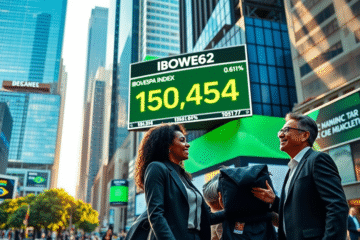Selic Rate Maintenance and Its Economic Impacts
The Selic Rate It is one of Brazil's main monetary policy tools and its definition directly impacts the country's economy.
In September 2025, the Monetary Policy Committee decided to maintain it at 15% per year, in response to external instability and persistent inflation.
In this article, we will explore the reasons for this decision, as well as the impacts that maintaining the Selic rate could have, such as an economic slowdown and the migration of investors to fixed-income assets.
We will also analyze the importance of international diversification in the face of this challenging scenario.
Selic rate maintained at 15%: decision and justifications
The Central Bank, in a decision taken on September 17, 2025, decided to keep the Selic rate fixed at 15% per year.
This choice is mainly due to two factors: inflation off target and the external instability.
Even with initial signs of deflation, inflationary challenges continue to put pressure on the Brazilian economy, reflecting the need for a tighter monetary policy.
As highlighted by Central Bank of Brazil, inflation expectations for 2025 and 2026 remain above the established targets.
In the external scenario, volatility makes it difficult to make safe economic forecasts, requiring caution in domestic policy.
Central justifications include:
- Persistent inflationary pressures
- Unstable global environment
- Domestic tax risks
This situation is aggravated by the high interest rate, directly and negatively influencing the cost of credit and slowing economic growth in crucial sectors.
Internal Macroeconomic Effects
Maintaining the Selic rate at 15% per year directly impacts the pace of the Brazilian economy, as stricter monetary policy measures tend to slow economic growth.
This increase in the rate influences the confidence of economic agents, who may be more cautious when making investments and spending.
Furthermore, the business environment is becoming more challenging, with the cost of credit increasing and the attractiveness of fixed income assets surpassing that of equities, which could lead to investor migration.
Slowdown and Sensitive Sectors
A Selic rate of 15% severely impacts the retail and construction sectors in Brazil.
The highest cost of credit discourages installment consumption, directly affecting retail sales that depend on flexible installments.
According to the Veja portal, consumers opt for more essential purchases and reduce the consumption of superfluous items, frustrating the growth of this sector.
Furthermore, investments in civil construction also suffer, as the increase in financing costs discourages new real estate projects, as pointed out by CBIC.
Therefore, sectors that are highly dependent on credit face a reduction in their profits as investors seek more stable opportunities abroad through international diversification.
- Drop in demand for installments
- Delay in new real estate projects
- Reduction in retail sector profits
Cost of Business Credit
Selic at 15%
significantly impacts companies with debts indexed to floating rates, such as those linked to the CDI.
The main effect is a substantial increase in the cost of credit, challenging corporate financial health.
Consider, for example, the difference between conditions before and after discharge:
| Before | After |
|---|---|
| CDI+2% | CDI+2% |
.
Therefore, companies see an abrupt increase in interest payments, putting pressure on financial planning.
Therefore, it becomes crucial that companies reevaluate their capital strategies, prioritizing fixed rate debts to mitigate risks and protect your working capital.
Reviewing and adapting is essential, ensuring sustainability amid economic challenges.
Repercussions on Financial Markets
Maintaining the Selic rate at 15% per year has profound repercussions on Brazilian financial markets.
With high rates, pricing financial assets becomes increasingly challenging, as the present value of future cash flows decreases, negatively impacting stock valuations.
Furthermore, the attractiveness of fixed-income assets increases, leading to the migration of investors to these investments and, consequently, further impacting the stock market.
Stock Pricing
The increase in the Selic rate has a significant impact on the pricing of shares on the Brazilian stock exchange.
This is because the higher the interest rate, the lower the interest rate tends to be. present value of companies' future cash flows.
The cash flow discounting mechanism uses the Selic as a reference rate, and with its increase, this technique results in a lower present value estimates of future profits, harming the valuation of companies.
Consequently, stock valuation is compromised, and investors' appetite for risk decreases.
For more details, explore the full analysis here.
Migration to Fixed Income
The increase in Selic rate for 15% in Brazil makes fixed income investments extremely attractive.
Profitability guaranteed by securities such as Tesouro Direto and CDBs exceed the return of many stocks on the stock exchange, directly affecting the stock market.
Thus, there is a portfolio reallocation of investors, who seek security and stable returns.
This results in decreased liquidity in the stock market, putting further pressure on stock prices.
Consequently, the decreased risk appetite leads to an adjustment in the economic scenario, which highlights the importance of international diversification to mitigate the risks associated with the local scenario.
International Diversification
International diversification offers a essential protection against the volatility of the Brazilian domestic market, especially in a high Selic environment.
Including foreign assets in an investment portfolio allows investors to access economic contexts with different cycles of the Brazilian.
Therefore, even when interest rates in Brazil reach high levels, such as the current 15%, exposure to international markets helps to dilute localized risks and enables gains in sectors that may not be available domestically.
Furthermore, the currency nature of this type of diversification offers a natural cover against fluctuations in the Brazilian exchange rate, which becomes even more relevant in an unstable global economic scenario.
Investing in international diversification is, therefore, a smart strategy to improve risk-adjusted returns, expanding investors' horizon of opportunities.
In conclusion, the decision to maintain the Selic Rate at 15% reflects significant economic challenges.
Understanding their impacts is crucial for investors and companies, especially in an environment that requires risk mitigation and diversification strategies.



0 Comments